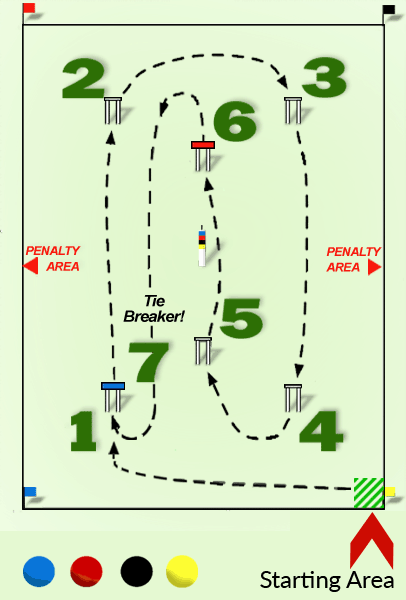
SAN FRANCISCO CROQUET CLUB
Synopsis of SFCC Golf Croquet
There are several versions of croquet played around the world. Most people in the U.S. who have played croquet before, probably played the backyard, nine hoop version popular in yards and parks across America. Unless otherwise requested, we use a simpler version of croquet for private events called Golf Croquet.
After a brief explanation of the rules, we'll just jump in and start playing. It is very easy to learn and play even for people who have never payed croquet of any type before. It's also lots of fun and just challenging enough to provide moments of triumph!
How To Play
 Golf Croquet is played between two sides — the blue and black balls versus the red and yellow balls. In singles each player plays two balls; in doubles each player plays the same ball throughout the game.
The object is to be the first side to score four points. A side scores a point when one of its balls is the first to pass through the next hoop in sequence, as shown in the illustration. Note that each hoop is scored by only one ball, so that both sides are always contesting the same hoop.
If after scoring six points the game is tied at three all, hoop #1 is contested again to break the tie.
Play is made by striking a ball with a mallet. The player who is playing a turn is called the striker, and the ball in play for that turn is the striker's ball. Turns are played in the sequence blue, red, black, yellow. This sequence of colors is painted on the peg in the center of the court. Each turn consists of one, and only one, stroke. There are no extra shots earned by hitting other balls with your ball or scoring a hoop with your ball. One turn, one stroke.
The striker must strike the ball with one of the mallet's two end faces, never with a side face or the shaft. The striker must strike the ball cleanly and only once during the stroke.
Golf Croquet is played between two sides — the blue and black balls versus the red and yellow balls. In singles each player plays two balls; in doubles each player plays the same ball throughout the game.
The object is to be the first side to score four points. A side scores a point when one of its balls is the first to pass through the next hoop in sequence, as shown in the illustration. Note that each hoop is scored by only one ball, so that both sides are always contesting the same hoop.
If after scoring six points the game is tied at three all, hoop #1 is contested again to break the tie.
Play is made by striking a ball with a mallet. The player who is playing a turn is called the striker, and the ball in play for that turn is the striker's ball. Turns are played in the sequence blue, red, black, yellow. This sequence of colors is painted on the peg in the center of the court. Each turn consists of one, and only one, stroke. There are no extra shots earned by hitting other balls with your ball or scoring a hoop with your ball. One turn, one stroke.
The striker must strike the ball with one of the mallet's two end faces, never with a side face or the shaft. The striker must strike the ball cleanly and only once during the stroke.
